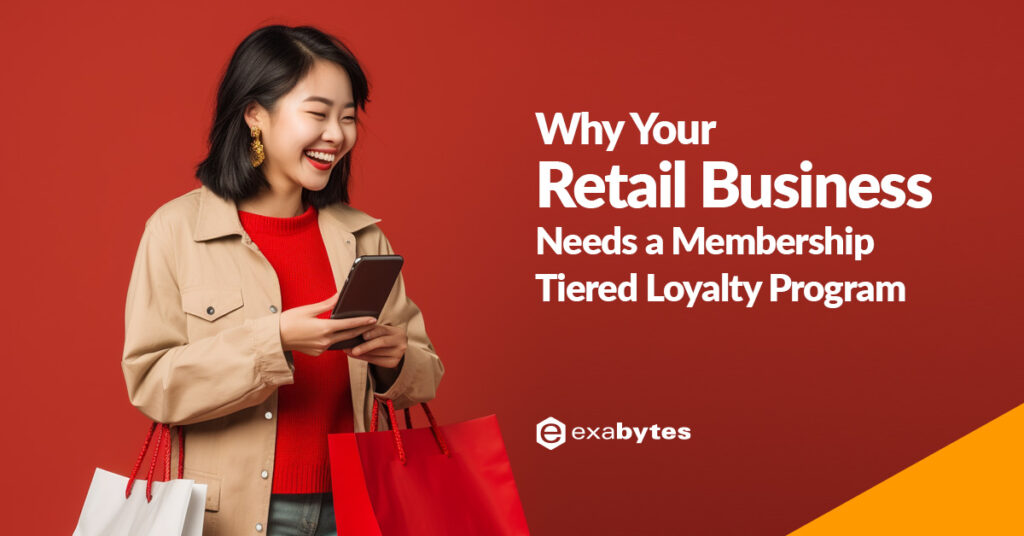[ad_1]

Since Jack Ma mentioned at the 2016 Alibaba Cloud Conference that “there is no e-commerce in the future, only NEW RETAIL,” the concept of “NEW RETAIL” has gained immense popularity through various media outlets.
Seven years have passed, and today, we can see that NEW RETAIL is not just a trend but an inevitable evolution.
The key elements of retail, namely “people, goods, and place,” especially the aspect of “people,” have undergone significant changes in consumer behaviour due to the evolution of technology.
Naturally, the relationship between “goods” and “place” has also evolved. This transformation not only alters people’s expectations and demands but also presents new challenges and opportunities for retail brands.
Today, we will explore the important aspect of retail—the management and marketing of “people,” with a focus on the Membership Tiered Loyalty Program. We will also share the importance of a Membership Tiered Loyalty Program and its role in effective marketing.
We hope this discussion will assist you in seizing more business opportunities in the fiercely competitive market.
What is a Membership Tiered Loyalty Program and how does it work?
A Membership Tiered Loyalty Program is a commonly used membership management approach in the retail industry. It involves evaluating the contribution of members and categorizing them into different levels.
The primary goal is to guide members to make purchases and enhance their loyalty more effectively.
The program utilizes the Recency, Frequency, Monetary Value (RFM model) as key metrics for analyzing customer behavior and classifying them based on three factors:
- Recency (R): The time passed since the customer’s last purchase.
- Frequency (F): The frequency of a customer’s purchases.
- Monetary Value (M): The amount of money a customer spends on purchases.
The RFM model assigns scores to each customer based on these three factors and then segments customers into different groups. This enables decision-makers to better understand their customers and develop personalized marketing strategies for each segment.
In short, a Membership Tiered Loyalty Program involves categorizing and managing members based on their behavior analysis. It is an effective strategy to enhance the customer experience and stimulate business growth.

Why is a Tiered Loyalty Program necessary?
The need for a Tiered Loyalty Program arises from the significant variations in contribution among different members. Some members may spend RM5,000 in your store within a year, while others may only spend RM15. Averaging these contributions can lead to inaccuracies in budgeting and marketing activities.
The common result is that loyal customers do not receive the discounts and perks they deserve, missing out on opportunities to spend more. On the other hand, occasional customers may receive loyal customer benefits without making significant contributions, potentially discouraging them from making additional purchases.
Both brands and customers are unlikely to appreciate such outcomes.
However, by implementing a tiered system that classifies members as high contributors, moderate contributors, low contributors, or even non-contributors (members who haven’t made any purchases throughout the year), and considering the average contribution per person, a clearer picture of the average contribution at each level is made available.
This approach allows for a more precise targeting and the use of different marketing strategies and incentive plans. It enhances the satisfaction of loyal customers, encourages the activity of low-contributing members, and enables a more comprehensive approach to member management.
Ultimately, this strategy improves the overall efficiency of marketing efforts.

Benefits of a Tiered Loyalty Program for Brands and Customers
As far as we know, the formula for budgeting sales in a retail store is:
Sales = Foot Traffic x Conversion Rate x Average Transaction Value
Here, three variables influence sales:
- Foot Traffic: The total number of people entering the store.
- Conversion Rate: The percentage of people entering the store who make a purchase (shown as a percentage of total foot traffic). For example, a 2% conversion rate means that for every 100 people entering the store, 2 make a purchase.
- Average Transaction Value (ATV): The amount spent by a customer in a single transaction (usually an average value, such as RM35).
Multiplying these three numbers together allows us to estimate the store’s sales or identify areas for improvement.
For an e-commerce store, the formula might be different but carry the same meaning:
Sales = Traffic x Conversion Rate x Average Order Value
When we examine these three variables, the one that typically has the most significant impact on performance is foot traffic. In essence, whether a business is doing well or poorly often depends on how many people enter the store (or visit the website).
Even if you achieve a 100% conversion rate (meaning everyone entering the store makes a purchase), it’s meaningless if the number of customers drops significantly.
Recently, there’s been lots of discussion on OMO (Online Merges with Offline)—integrating online and offline channels to create a synergistic effect, just like the saying ‘1+1 is greater than 2’.
Now, let’s add another variable to the equation:
Sales = Traffic x Conversion Rate x Average Order Value x Repeat Purchase Rate (Customer Loyalty)
If your brand can accurately calculate the repeat purchase rate of customers compared to competitors, it may be the key to future market competitiveness. How do we achieve this?
Through the collection and analysis of digital data, effective customer loyalty management focuses on increasing the repeat purchase rate for each member.
The core value of a Tiered Loyalty Program lies in enhancing customer loyalty and, consequently, the repeat purchase rate. Only by categorizing customers into different tiers can personalized marketing effectively engage with customers at various levels.
Brands can design specific marketing activities based on data, encouraging the consumption interests of members with different contribution levels and getting closer to their needs and preferences. This, in turn, improves sales performance.
For customers, high-contributing members receive unique, high-value perks; moderate contributors receive recommendations to enhance their spending; and low contributors receive targeted promotional activities.
Everyone gets what they want, resulting in the best outcome for both brands and customers.

Challenges Faced by Malaysian Retailers in Implementing Membership Tiered Loyalty Programs
1. Data Collection and Integration
Gathering, integrating, and analyzing a large volume of member data requires cutting-edge technologies and systems. For some brands, especially small retailers, there may be a lack of resources in this area.
2. Infrastructure Alignment
To effectively implement a Membership Tiered Loyalty Program, brands not only need advanced technological infrastructure, including data storage and analysis tools, but also need to synchronize with other operational systems such as POS systems and finance systems.
The investments and the need for relevant technical expertise often discourage many retailers from pursuing such initiatives.
3. Internal Organizational Willingness and Guidance
Adopting a new system and operational processes typically requires coordination across multiple departments, including staff training. If the intentions and goals are not clearly communicated to internal staff, these technologies may remain impractical.
Therefore, ensuring positive support and understanding from the internal organization is crucial for the success of adapting to new changes.
Exabytes New Retail Solution: Helping Brands Establish a Membership Tiered Loyalty Program
Solution (1): Achieving Automatic Data Collection with Minimal Manpower
Solution (2): Over 400 Promo Templates for Different Membership Tiers
Solution (3): Streamlining Personalized Marketing through Automated Information Generation
1) Achieve Automatic Data Collection with Minimal Manpower
From the moment a customer joins as a member, they are automatically categorized based on factors such as past purchase frequency and willingness to buy. This enables marketers to easily select and push targeted messages.
Within this framework, the NAPLRS Membership Tiered Loyalty Program segments members into different categories, including:
– New: Customers making their first purchase
– Active: Customers with two or more purchases
– Potential: Customers with two or more purchases but haven’t bought in over three shopping cycles
– Lost: Customers who made a first purchase but haven’t bought in over three shopping cycles
– Ready to Buy: Customers who registered but haven’t made a purchase
– Sealed: Customers who made a purchase but haven’t bought in over a year



Additionally, the Purchase Intent Model (DCIU) categorizes customers into different types:
– Deciding: Customers who are ready to make a decision
– Considering: Customers who are still considering and have not made up their mind
– Enquiring: Customers who are seeking information
– Uninterested: Customers who have no interest


2) Over 400 Promo Templates Generated for Various Membership Tiers on a Single Page
With over 400 promotional templates, you can efficiently create a single page with different offerings for different membership levels within the Membership Tiered Loyalty Program. Even for the same promotion, you can provide varying degrees of discounts to different members on the same page, saving time and effort.


3) Automated Selection and One-Click Information Generation – Simplifying Personalized Marketing
Introducing 10 new highly useful templates, making a total of 16 templates to help brands maintain high-quality connections with members from four aspects.
Additionally, an AI content generator has been integrated, providing a convenient and efficient tool for personalized marketing!
– Connect with new customers
– Encourage orders
– Boost customer loyalty
– Reconnect with lost customers

Conclusion
All in all, the Membership Tiered Loyalty Program is a method of efficiently allocating resources. As the old saying goes, “Treat those who are good to you even better.”
Moreover, research indicates that high-contributing members typically constitute only 5% of the total membership, while low-contributing members often make up the majority.
If a brand can accurately identify its high-contributing members and pamper them, strategically elevating the mid-contributing members to high contributors, it can undoubtedly maintain a stronger competitive edge amid the continuous rise in marketing expenses.
The good news? What seemed challenging in the past can now be easily achieved with the help of these powerful tools!
Request A Demo
Let our consultants demonstrate this value-driven new retail solution for you!
Related References:
- 新零售狂潮 | 刘润 | 2019 | 宝鼎出版
- 新零售进化论 | 陈欢,陈澄波 | 2019 | 日出出版
- 為什麼要做會員分級制度?
- 零售業的業績方程式
- 浅谈零售业会员体系
- 新零售会员营销思路及策略
- Should You Be Offering Tiered Membership Levels?
- From Bronze to Diamond: How Tiered Loyalty Programs Can Boost Your Business Strategy in 2023
- What Is Recency, Frequency, Monetary Value (RFM) in Marketing?
[ad_2]
Article link





